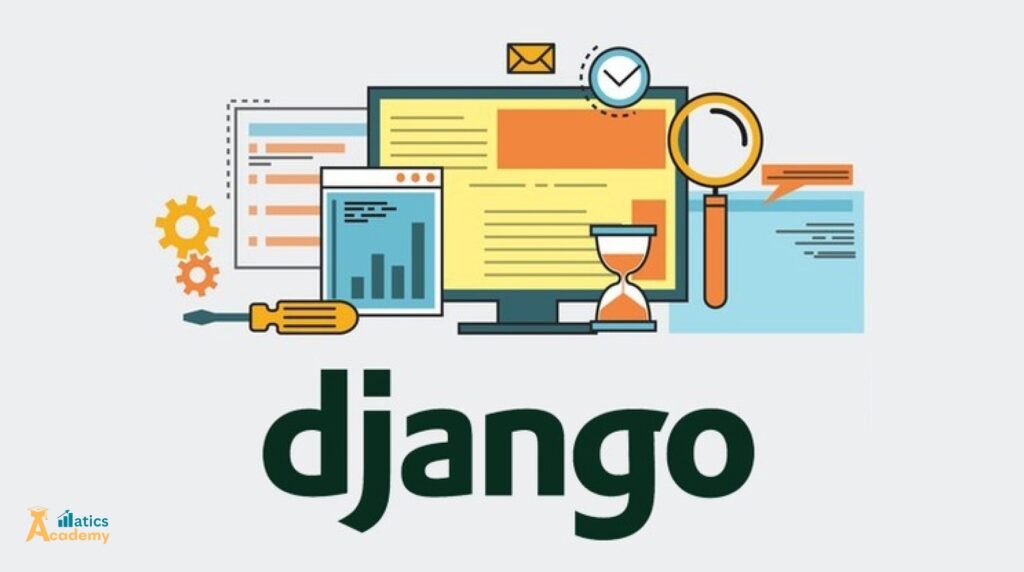Introduction to Django
Django is a high-level Python web framework that enables rapid development with clean, reusable, and maintainable code. This Django tutorial will guide you through the steps to get started. It follows the Model-View-Template (MVT) architecture and is known for its scalability, security, and efficiency.

Why Use Django?
- 🚀 Rapid Development – Reduces development time with built-in tools.
- 🔒 Security – Prevents common threats like SQL injection and CSRF attacks.
- 📊 Scalability – Handles high traffic and complex applications efficiently.
- 🔄 Reusability – Encourages modular code with reusable components.
- 🛠️ Built-in Features – Includes authentication, admin panel, ORM, and more.
Django Features
Django comes with many powerful features, including:
- Object-Relational Mapping (ORM) – Works with relational databases like PostgreSQL, MySQL, and SQLite.
- Admin Interface – Auto-generates a web-based admin panel for database management.
- URL Routing – Maps URLs to views easily using
urls.py. - Middleware Support – Handles authentication, security, and caching.
- Built-in Authentication – Provides secure user authentication.
- Scalability – Supports high-traffic applications efficiently.
Installing Django
To install Django, ensure Python is installed. Then, use:
pip install django
verify Installation:
django-admin --version
Django Applications & Use Cases
Django is widely used in various domains:
- Web Applications – E-commerce, social media platforms
- APIs & Backend Services – REST APIs using Django REST Framework
- Content Management Systems (CMS) – WordPress alternatives like Wagtail
- Data Science & AI – Machine learning model deployment
- Enterprise Applications – ERP, CRM systems
- Fintech & Banking – Secure transaction-based applications
Creating a Django Project
To start a new project:
django-admin startproject myproject cd myproject python manage.py runserver
Creating a Django App
A Django project can have multiple apps. To create an app:
python manage.py startapp myapp
Then, add 'myapp' to INSTALLED_APPS in settings.py.
Django Models (Database Handling)
Django’s ORM allows easy interaction with databases. Example model:
from django.db import models
class Product(models.Model):
name = models.CharField(max_length=100)
price = models.FloatField()
stock = models.IntegerField()
def __str__(self):
return self.name
To apply changes, run:
python manage.py makemigrations python manage.py migrate
Django Views & URL Routing
Views handle request logic. Example view:
from django.http import HttpResponse
def home(request):
return HttpResponse("Hello, Django!")
Define the URL pattern in urls.py:
from django.urls import path
from . import views
urlpatterns = [
path('', views.home, name='home'),
]
Django Templates
Django Templates allow dynamic HTML rendering. Example:
index.html
My Django App
Welcome to Django
Rendering Template in Views
from django.shortcuts import render
def home(request):
return render(request, 'index.html')
Working with Django Forms
Django simplifies form handling. Example:
from django import forms
class ContactForm(forms.Form):
name = forms.CharField(max_length=100)
email = forms.EmailField()
message = forms.CharField(widget=forms.Textarea)
Django Admin Panel
To access Django’s built-in admin panel, create an admin user:
python manage.py createsuperuser
Then, log in at http://127.0.0.1:8000/admin/.
Django REST Framework (DRF) for APIs
To create APIs, install DRF:
pip install djangorestframework
Example API View:
from rest_framework.response import Response
from rest_framework.decorators import api_view
@api_view(['GET'])
def api_home(request):
return Response({"message": "Hello, API!"})
Deploying a Django Project
To deploy Django, use Heroku, AWS, or DigitalOcean.
Deployment Steps
1. Install Production Dependencies
pip install gunicorn whitenoise
2. Update settings.py
ALLOWED_HOSTS = ['yourdomain.com']
3. Run Migrations & Start Server
python manage.py migrate python manage.py runserver
Django vs. Other Web Frameworks
| Feature | Django | Java Spring Boot | Express.js |
|---|---|---|---|
| Language | Python | Java | JavaScript (Node.js) |
| Architecture | Full-stack (MVT) | Full-stack (MVC) | Minimalist |
| Admin Interface | Built-in admin interface | No built-in admin interface | No built-in admin interface |
| Development Speed | Fast (due to built-in features) | Medium (more setup required) | Fast (simple routing) |
| Scalability | Highly scalable | Highly scalable | Highly scalable |
| Security | Excellent (with built-in protections) | Excellent (strong security features) | Needs additional security measures |
| ORM | Powerful ORM (built-in) | Powerful ORM (Hibernate) | No built-in ORM |
| Flexibility | Moderate (convention over configuration) | High (highly configurable) | High (minimalist with custom flexibility) |
| Documentation | Extensive and detailed | Extensive and detailed | Good but less detailed |
| Best for | Full-scale apps, CMS, e-commerce | Enterprise-level applications, APIs | Real-time apps, APIs, microservices |
| Learning Curve | Moderate (due to its many features) | Steeper (requires understanding of Java ecosystem) | Moderate |
| Use Cases | Social networks, CMS, e-commerce | Large-scale enterprise applications | Real-time apps, microservices |
Career Opportunities with Django
Django is widely used in web development, making it a valuable skill for various job roles. Below is a table highlighting common Django-related careers, along with their estimated salary ranges in India (INR) and the USA (USD).
| Job Role | Average Salary (INR per year) | Average Salary (USD per year) |
|---|---|---|
| Django Developer | ₹4,00,000 – ₹10,00,000 | $50,000 – $120,000 |
| Backend Developer (Django) | ₹6,00,000 – ₹15,00,000 | $60,000 – $140,000 |
| Full Stack Developer | ₹5,00,000 – ₹18,00,000 | $65,000 – $150,000 |
| Django Web Engineer | ₹6,50,000 – ₹12,00,000 | $70,000 – $130,000 |
| Software Engineer (Django) | ₹7,00,000 – ₹16,00,000 | $75,000 – $140,000 |
| Machine Learning Engineer | ₹8,00,000 – ₹20,00,000 | $80,000 – $160,000 |
| Django API Developer | ₹5,50,000 – ₹12,00,000 | $60,000 – $125,000 |
| Data Engineer (Django) | ₹9,00,000 – ₹22,00,000 | $85,000 – $170,000 |
Why Consider a Career in Django?
- 🌍 Global Demand: Companies worldwide use Django for web applications, REST APIs, and data-driven projects.
- 💰 Competitive Salaries: Offers lucrative salary packages, especially for experienced developers.
- 🏆 Versatile Opportunities: Work in startups, MNCs, or freelance as a Django specialist.
- 📈 Growing Industry: Demand for Python and Django professionals is increasing, making it a future-proof career.
How to Start Your Career in Django?
- Learn Python & Django: Master Django fundamentals, including models, views, templates, and REST APIs.
- Build Projects: Create real-world applications like e-commerce websites, blogs, and APIs.
- Contribute to Open Source: Gain experience and recognition by contributing to Django-related projects.
- Apply for Jobs: Use platforms like LinkedIn, Indeed, and GitHub Jobs to find Django-based roles.
- Stay Updated: Follow Django’s official documentation and community forums for the latest trends.
Additional Topics:
Interview Questions:
1. What is Django’s architecture?(Infosys)
Answer:
Django follows MVT (Model-View-Template) architecture, where models define data, views handle business logic, and templates render the frontend.
2. What are middleware in Django?(TCS)
Answer:
Middleware are functions that process requests and responses globally before they reach views, used for authentication, security, and performance optimization.
3. How does Django handle database migrations?(Amazon)
Answer:
Django’s ORM uses makemigrations to track changes and migrate to apply them to the database.
Play with Django
Question
Your answer:
Correct answer:
Your Answers
